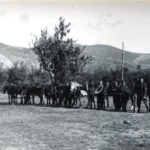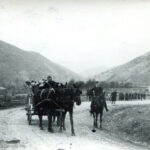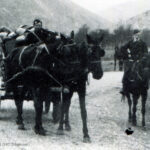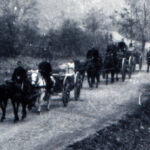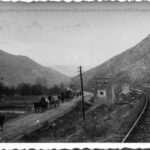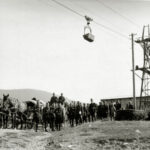- WW2 Russian Protective Corps Guide, map, battlefields & virtual tour
Cavalry School of Horseback and Sled Riding
On August 27, 1943, Prince Kudashev and I left Maidan Peka for Belgrade, where we were called to take a course at the German School of Horsemanship and Harness Riding (Reith und Far-Schule). 20 Russian officers gathered here, in German officer and non-commissioned officer ranks – cavalrymen, Cossacks and artillerymen. The school was organized to create a cadre of officer-instructors for mounted and mounted transport units and uniformly train them according to the latest method based on scientific research. The course lasted about a month. Study groups, 20 people each, replaced one another. Moreover, each group was of a certain nationality. The school was attended by German, Hungarian, Bulgarian, and Russian officers, but there were never mixed groups. The fact that not all of us wore officer’s shoulder straps, they explained to us that the Corps does not have the ability to send only officers, so a group of officers and non-commissioned officers – candidates for officer positions – is sent to the school, which completely satisfied the School authorities.
The permanent staff of the school, headed by a major general, the head of the school, was about 100 people, including the instructor, administrative and veterinary parts, as well as service personnel – grooms, cleaners, saddlers, blacksmiths, cooks and servants in the dining room.
The senior instructor, the young 27-year-old Major Halle, turned out to be a very knowledgeable teacher, a demanding and at the same time very nice and well-mannered officer. His assistants, three sergeants, were worthy of their boss.
Our entire group consisted of lovers of horses and everything connected with this noble animal. Each of us found many of our old friends and acquaintances here. We joyfully met here with Colonel M. Levandovsky, cornet Donchuk and many old friends.
The school was located in the barracks of the Yugoslav Guards Artillery, newly renovated. With pleasure we plunged into the atmosphere of a cavalry barracks, with the smell of the stables and horse sweat, the clatter of horseshoes on the cobblestones of the yard and the soft tramp of a trot in the arena, with the appetizing smell and soft creaking of light yellow leather of new saddles and harnesses, with a ringing neigh and the feeling of soft lips your pet, taking a piece of sugar or bread and salt from your palm with a light slap.
Usually there were practical lessons in the arena or in the field before lunch, and theoretical lessons after lunch. Sometimes there were changes, for example, in the morning in the field, riding carts, and in the afternoon horse riding in the arena. We enjoyed horseback riding, listening and gradually getting used to the German commands. Of course, there were some comic incidents. As a translator, they sent us a cavalry soldier from the German colonists from the Corps. He was not a very developed soldier, apparently, he served more in the infantry than in the cavalry, and was in no way suitable as a translator for the School. We endured his incredible translations of commands for two or three days, but when to change from a walk to a trot, he translated “trot… walk – march” and stubbornly, despite indicating incorrectness, continued in the same spirit. We were indignant and insisted on being replaced by one of us, cornet S. Moshin, and things went quite smoothly.
At first we treated the horse-drawn business like a cavalryman, with a condescending attitude, jokingly calling it a “sport cabman.” But then we fell in love with it just as much as horse riding. In addition to the little-known theory of harnessing, the design of harnesses and methods of controlling horses, which are truly based on long-term and thorough scientific research, we also learned a lot of new things in practical driving of German military-type carts. This ride took place on very rough terrain, with additional artificial obstacles installed on it. The carts were harnessed to a pair of horses, and to some were added one or two carriages with drivers, like an artillery harness. We sat down, alternately replacing each other, now on the goats, to control the reins, now on the rides, now on the hand brakes. Upon arrival at the training site, we began such a difficult ride that we were later surprised at how we ourselves, the horses, and the carts got out of it unharmed. It was necessary to show daring, agility, self-control, and intelligence. We flew up a steep hill in a quarry, paused at the top for a second and descended from it at a walk, braking the wheels tightly. Then we drove along a trench dug in a rectangular zigzag, with both right wheels and then both left wheels diving into the trench. After that, we crossed a steep and deep ditch, almost at the quarry, barely having time to tighten and immediately release the brakes. Finally, they descended along a high and steep slope to its middle, holding back the horses so that they sat on their rumps. Then we had to jump down onto a specially dug narrow terrace, about 3/4 meters high. Here it was no longer possible to restrain the horses, and we rushed down into the ravine, where the road was blocked by a ditch filled with water and earth thrown up on the opposite bank. The jump over it was, of course, especially difficult for a harness with drags, but after it we sighed with relief – this was the last test.
We ourselves were amazed at how we did not fly out of the cart during this tightrope walk. True, one of us almost fell under the wheels, flying from the seat of the sawhorse onto the drawbar while jumping onto the terrace, but everything ended, thank God, safely. It goes without saying that after our first trips we began to treat the “cab sport” with great respect and interest. By the end of the course, we overcame all obstacles without using the brakes.
Horse riding was nothing new for all of us and we practiced it as a favorite sport. The Cossack landing at first hurt the eyes of our “pretty” Major Halle, but his professional eye appreciated that they were experienced cavalrymen of a different school than himself, and he did not find fault with them excessively.
In the evenings, after classes, we were all free and could go out into the city, which many took advantage of, often not even spending the night in the barracks, but going there straight to classes.
We were reluctant to leave the hospitable walls of the school at the end of the course, having received “diplomas” as teachers of horseback riding and harness riding, but everything in the world – both good and bad – comes to an end…
On October 2 I am alone, because… Kudashev, due to illness, remained in Belgrade and went back to his Muster Company. Workdays began again, with guard duty and reconnaissance in the mountains.
Our cadets completed their course and were promoted to second lieutenants. It was a shame for them that such a moment, which is not forgotten by officers all their lives and is usually, in normal circumstances, celebrated very solemnly, took place in Maidan-Pek, the entire garrison of which consisted of our company and a heavy platoon. (by V. Cherepov)
- “Rashka, hitching post” (horse parking) N B39
- “Trip Rahove – Mitrovica 8th hundred of 3rd regiment, artillerymen are moving to position” (N B40)
- Horse-drawn carriage with cargo (N B40 fragment)
- The same artillery column, view from the other side, 1942 (B41)
- Transition from Post N20 to Rudnitsa (?Germans) B41
- The famous air line from Zvecan to Rahove, B42

